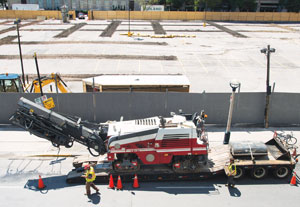Work is already beginning at the site of the massive new courthouse planned for Toronto but it’s likely to be several years before it opens its doors, according to the Ministry of the Attorney General.

“The Ministry of the Attorney General and Infrastructure Ontario are in the planning process for the new courthouse, and have begun working with consultants to conduct surveys, environmental assessments, and soil testing on the site,” wrote ministry spokesman Brendan Crawley in response to a request for an update on the courthouse. The site chosen for the courthouse, he said, is a government-owned piece of land just north of the existing Superior Court of Justice at 361 University Ave. Previously a parking lot, it was closed to the public earlier this month.
Crawley declined to provide an estimate of when it would be complete but noted similar courthouses have taken five to seven years “to build and become fully operational.”
The new courthouse, announced in the provincial government’s 2014 budget, will “better serve Toronto by bringing together many justice programs and services in a single location.” He declined to specify, however, whether the new building would include facilities for civil as well as criminal matters and what would happen to existing courthouses.
It’s also too early to say anything about the cost of the building, he noted.
“Because we will be conducting a competitive procurement process, we do not release cost estimates prior to
financial close, as this would compromise our ability to obtain the best value bid,” he said.
“Once the procurement phase for the project is completed, the project cost and contract with the successful bidder will be released publicly and posted on Infrastructure Ontario’s web site.”
The government is to post details of a request for proposals on the Infrastructure Ontario web site this summer.
Stephen Mullings, vice president of the Toronto Lawyers Association, says the organization’s members are happy with the project, especially since it will amalgamate a lot of court spaces from across Toronto into a centralized location downtown. The size of the building, he adds, is reportedly quite considerable given suggestions it will be anywhere from 14 to 30 stories.
Jody Berkes, vice chairman of the Ontario Bar Association’s criminal justice section, says the new courthouse will house the Ontario Court of Justice and will include facilities for hearing both criminal and family law cases. The government will likely consolidate existing criminal and family court facilities at 47 Sheppard Avenue E. and 311 Jarvis St. into the new facility or repurpose them, he says.
Berkes, who says he’s happy with how the province has been consulting with the Ontario Bar Association on the project, notes the new courthouse will likely feature a number of innovations. They include a number of meeting rooms for families and services for self-represented litigants to get legal information.
Berkes says his understanding is that the new building won’t include facilities for civil cases, a fact that’s likely to disappoint civil litigators who are unhappy with existing court space.
Whatever plans the province has for the new building, it desperately needs new facilities to replace the “squalor” of rented space at 393 University Ave., says Robert Harrison, a partner at Fasken Martineau DuMoulin LLP’s Toronto office. “It’s an appallingly squalid accommodation that is not worthy of this city or the justice system. It’s an office building, for crying out loud. If you put more than 10 people in one of these courtrooms, you just suffocate. It’s just horrible.
“The most senior civil court in this city is getting short shrift, and I just think it’s appalling. I can’t believe that they’re continuing to let that squalor be the place for civil cases to be tried in front of Superior Court judges.”
To Sylvia Jones, the Progressive Conservative critic for the attorney general, a scarcity of information about such an important project reflects a lack of transparency on the part of the government. She says she has been unable to get answers from the government as to how much court administration it intends to consolidate into the new building and whether such a move is practical. “If you’re going to do that kind of a build, presumably there is a business case somewhere that says these are the benefits, whether the benefits are fiscal or logistical, and I’ve never seen that laid out,” says Jones.
The construction of the new courthouse also raises questions about what happens to the existing facilities elsewhere in the city, she says.
Once surveys, environmental assessments, and soil testing are complete, the ministry will issue a request for qualifications for a project team to design, build, finance, and maintain the project, said Crawley. The ministry expects to release the request for qualification next summer.

 “The Ministry of the Attorney General and Infrastructure Ontario are in the planning process for the new courthouse, and have begun working with consultants to conduct surveys, environmental assessments, and soil testing on the site,” wrote ministry spokesman Brendan Crawley in response to a request for an update on the courthouse. The site chosen for the courthouse, he said, is a government-owned piece of land just north of the existing Superior Court of Justice at 361 University Ave. Previously a parking lot, it was closed to the public earlier this month.
“The Ministry of the Attorney General and Infrastructure Ontario are in the planning process for the new courthouse, and have begun working with consultants to conduct surveys, environmental assessments, and soil testing on the site,” wrote ministry spokesman Brendan Crawley in response to a request for an update on the courthouse. The site chosen for the courthouse, he said, is a government-owned piece of land just north of the existing Superior Court of Justice at 361 University Ave. Previously a parking lot, it was closed to the public earlier this month.